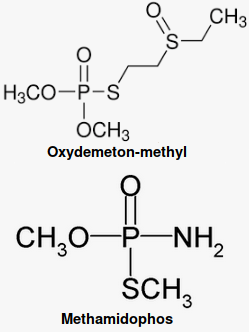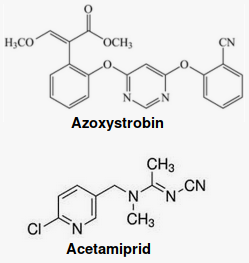 his week the UK Daily
Mail and the UK
Guardian
released nearly identical stories claiming that an “unhealthy number of
dangerous pesticides are in 20 percent of all popular fruit and vegetables.”
The story comes from
Consumer
Reports (CR), the magazine that used to tell us which toaster we
should buy. Now they're trying to read the science, which is a welcome
development. But what they're using it for is to generate panic.
his week the UK Daily
Mail and the UK
Guardian
released nearly identical stories claiming that an “unhealthy number of
dangerous pesticides are in 20 percent of all popular fruit and vegetables.”
The story comes from
Consumer
Reports (CR), the magazine that used to tell us which toaster we
should buy. Now they're trying to read the science, which is a welcome
development. But what they're using it for is to generate panic.

Caution: may contain potatoes (frozen shredded potatoes). This is the
closest I have to a vegetable; must go to the grocery store soon
A few years ago I'd buy a carton of blueberries only to find that half the ones in the middle, not visible through the plastic, were stuck together with white mold. The same was true of many fruits and vegetables. I still have nightmares about that plastic-wrapped corn on the cob from a grocery store. How did they fix that problem? With chemicals and better packaging.
Every chemical is toxic at some concentration. Whether it exceeds hazardous limits depends on its biological effect, the amount taken up by the body (known as bioavailability), and the chemical's rates of absorption and elimination.
Whether the EPA sets the limits fairly or not, the idea that they should be lowered because a farm in a foreign country is out of compliance doesn't make sense. Lowering the limits would greatly increase the number of samples the EPA considers dangerous. What would happen? People would be even more terrified and demand the levels be lowered even more. It would be as if the solution to too many cars exceeding the speed limit was to lower the speed limit.
Every EPA bureaucrat knows that setting unattainable limits only weakens their authority. Bureaucrats live for the rules. If people become convinced the EPA limits are based on hysteria instead of science, the bureaucrats lose their reason for existence (which some would say is hanging by a thread as it is).

Structure of oxydemeton-methyl and methamidophos, typical
phosphorothioate insecticides. The sulfur atom is the key to
their specificity against insects, which replace the sulfur with an oxygen,
making them active. Insects perform this reaction much faster than
mammals. In mammals and birds, enzymes in the blood plasma called
carboxylesterases detoxify the molecules instead. Once the
molecules are activated, they block insect acetylcholinesterase,
an enzyme that breaks down the
neurotransmitter acetylcholine
Most samples were below detection limits
Both newspapers said (with almost identical wording) that strawberries 'contain' oxydemeton-methyl, which they say is a neurotoxin that can disrupt children's development. Oxydemeton-methyl is a typical organophosphate that does indeed act as a neurotoxin—to insects. The ‘development’ risk comes mainly from reports on zebrafish, but higher concentrations have also been shown to harm rats and mice.
That might sound bad, but if oxydemeton was ever mentioned in the CR article it's no longer there. The USDA report lists a grand total of zero of the 705 samples of any food tested, including strawberries, as containing any detectable oxydemeton methyl or its metabolite oxydemeton methyl sulfone. Nor could I find any articles in PubMed or PubChem, which replaced the old Toxnet database.
Then there are the deadly domestic green beans. CR writes “Methamidophos levels [in green beans] were more than 100 times the level CR's scientists consider safe.”
What CR scientists? Where are they getting this? CR is not capable of doing scientific research. What they actually did was go to the USDA website and do an online search of their database. You can read the USDA's 246-page summary report here. The third paragraph flatly contradicts CR's claims:
This Annual Summary report shows that when pesticide residues are found on foods, they are nearly always at levels below the tolerance, or maximum amount of a pesticide allowed to remain in or on a food, which is set by the U.S. Environmental Protection Agency (EPA). More than 99 percent of the products sampled through PDP had residues below the established EPA tolerances.

Methamidophos levels in green beans above the
EPA limit. Of 530 samples, 28 (5.3%) were above
the EPA limit. The highest two were from Guatemala.
18 more (not shown) had detectable levels below the limit. The
other 484 samples (also not shown) had undetectable levels
Precautionary principle
Here's the most important sentence in the article, attributed to someone at CR:
We take a precautionary approach to make sure we don't underestimate risks.
In other words, it's the precautionary principle again. CR admits that more than 99% of the foods contained pesticide residues below the EPA's legal limits. So what they're really doing is to scare people into demanding that the EPA lower the limits.
The USDA Results
Methamidophos is produced by bacterial or chemical degradation of the insecticide acephate. It is more toxic than acephate due to its nonspecific effects on nicotinic acetylcholine receptors and its higher solubility in water. Toxicity studies generally report toxic effects at dosage levels of 50–500× the EPA limit of 0.02 ppm. In the USDA report, the highest level of methamidophos in green beans was 0.68 ppm, 34 times the EPA limit. Where CR's 100× figure comes from I have no idea. The graph at right shows the distribution. The five highest levels were all from Mexico or Guatemala. Only 28 out of 530 samples were above the EPA limit. Another 18 were below the EPA limit but above the lower limit of detectability. The other 484 data points where levels were undetectable aren't shown here for lack of space.
A common error is to simply report that something was ‘detected’ or ‘found’. With enough effort, you can ‘detect’ anything in anything. At a minimum we need to know how much was actually found and the lower limit of detection (LLOD). Saying that some food “contains” some toxic substance or that something was “found” is meaningless without this information. Unlike the USDA, most commercial labs will not even report a number unless it's at least ten times the LLOD.
For example, the USDA 'found' 2,6-DIPN, a plant growth regulator, in 16 out of 529 samples of potatoes. The LLOD was 0.02 ppm. The bad samples contained 0.022 to 0.56 ppm. The EPA limit for 2,6-DIPN in potatoes was 2.0 ppm. So according to the EPA they are all safe to eat.

Structures of azoxystrobin and acetamiprid. A bit scary looking
with that cyanide moiety, so don't pour them on your cereal
Or take the pesticide acetamiprid, which was found in 31.3% of fresh blueberry samples. The range was 0.002 to 0.83 ppm. All were below the EPA tolerance level, which is 1.6 ppm. Azoxystrobin was detected in 65% of the potato samples at levels of 0.011 to 1.2 ppm. Not a single sample was above the EPA tolerance level of 2.0 ppm.
We don't want pesticides in our food. If some country is exporting food to us with toxic levels of chemicals, there are adequate means of dealing with it. But CR's claim that “20% of fruits and vegetables in our analysis posed a high or very high risk from pesticides” is not backed up by the USDA data.
Forever and ever and ever chemicals
Just once before I die, I'd like to see one scientific article that says something is not a potential problem. It's nearly impossible to get something like that published; certainly no scientist in industry would bother trying. Finding problems is in a scientist's job description and it's ruthlessly enforced by journal editors.
When I worked in a toxicology lab before entering grad school, our job was to discover why one particular industrial chemical was causing cardiomyopathy. My boss's theory was that it was metabolized in the heart to something else which was highly reactive. That meant it was tough to measure. My task was to invent a new way to enrich the sample by a few thousand fold while keeping it intact so we could detect it, which we did.
My boss's theory turned out to be wrong. The chemical was metabolized in the blood vessels, not the heart where the injury occurred. That's typical of toxic substances, many of which are perfectly harmless until they reach the liver, which turns them into poisons in its attempts to metabolize them.
I'm proud of the fact that we never sensationalized our results. We never claimed it was a public health hazard. We stuck to the science.
“Forever chemicals” are the opposite. They stick around longer than others (though certainly not “forever”) because they aren't easily metabolized to anything more toxic. That's not to say something unreactive is always safe. But if I had to choose between a forever chemical and a chemical that was metabolized in my liver—or in some bacterium—to something nasty and carcinogenic, I'd pick a forever chemical every time.
As for fungicides: if people had any clue just how toxic some of those molds are in their food, they'd be clamoring for food producers to pour fungicide all over it. And don't get me started about the dangers of toxins found naturally in foods like cassava, which contains linamarin and lotaustralin. If cassava isn't prepared properly, these natural chemicals will generate enough cyanide to kill you in two hours. Other vegetables produce toxic chemicals, including acrylamide from potatoes, during cooking.
Does the Mail or Guardian mention any of this? No, and neither does CR. That's why when I started my own lab we had a firm policy: never let any reporter in. If one got in, our policy was to shoot—I mean shoo, not shoot—them. Our big DANGER: LAND MINES sign kept most of them out. Too bad the Safety guy—rest his soul—made us take it down.
apr 20 2024, 4:52 am. last updated apr 20 2024, 6:47 pm.
